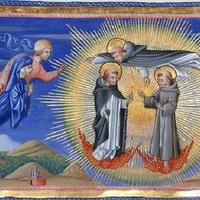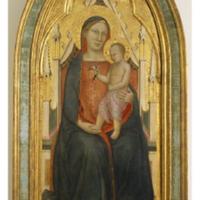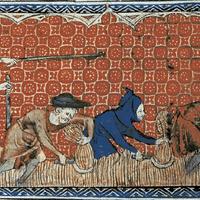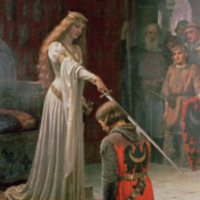Browse Exhibits (47 total)
Avarice and Greed Through Time
The exhibit Avarice and Greed Through Time is a collection of multimedia works spanning the 15th and 21st centuries that explore the changing outlooks on the two values.
Changes in attitudes towards avarice and greed can be seen when unpacking art spanning these centuries. Works from the medieval period heavily embody the condemnation of avaricious behaviors, whereas those from the 21st century explore the ways in which greed has become normalized and celebrated.
Throughout history, there has been a drastic change in the outlooks on avarice and greed, which are both characterized by an insatiable desire for wealth or material gains. A central Christian belief in medieval times was that these values were the primary opposing forces to the religion, as they were seen as the worst vices and root of all evil.
The shift in the world's economic systems, alongside the prominence of capitalism, has created an environment in which greed has become largely destigmatized and encouraged in the 21st century. In contrast to Dante’s medieval world, the focus has strayed from the pursuit of virtue and a widely accepted consensus on the criticism of greed for its immoral nature. Although avarice and greed are still heavily criticized today, there is no longer the steadfast denunciation of the traits that existed in medieval times.
Ecclesiastical Hypocrisy

This exhibit explores the complex relationship between the clergymen of the Catholic Church and the gospel. From the works of Dante Alighieri to Andrea Landini, I will explore how clergymen strayed from their teachings to the point where they no longer represented the gospel. Although this change is one that occurred very slowly and had, this exhibit focuses primarily on the Middle Ages and the practices of the Catholic Church during the era.
Patronage as Penance

The 14th century in Italy was period time of economic growth - a time when the pockets of Italy's richest men became even deeper. However, the Catholic church condemned hoarding wealth, and many merchants were the subject of scrutiny from the religious world. Throughout the 14th and 15th centuries, many patrons commissioned religious artwork featuring themselves as positive figures, as a way of demonstrating their piety and a form of penance for their sins.
Patronage as Penance is a collection of some examples of this tradition across the 14th and 15th centuries.
Medieval Labor’s Role in Feudalism’s Decline

The restructuring of the labor class during the late medieval age contributed to the decline of feudalism. The Black Death killed between 30% to 50% of the entire population of Europe. The unparalleled decline in population resulted in the empowerment of workers and provided financial opportunity in urban centers. The change of warfare represents a retooling of the feudal pyramid. The transition from medieval to early modern warfare saw the emerging obsolescence of knights and birth of gunpowder. These changes are best represented by the Hundred Years’ War and the beginning of a more centralized monarchy. The movement of power away from the land-based feudal structure towards emerging urban centers and the rise of nation-states was catalyzed by demographic shifts, economic transformation, and evolving military tactics, contributed directly to the decline of feudalism. This shift fundamentally reshaped societal dynamics and power structures, laying the groundwork for the modern world we inhabit.
The Art of Religious Corruption

Religion and art interwine, one rarely exists with out some form of the other. In it's early stages, art would be used as a way to teach and inspire religious awe. Churches served as both religious and political authorities, tasked with prioritizing the pursuit of God and spiritual salvation above all else. As populations grow, and power and wealth become more alluring so does the corruption of the church. Where there is corruption, there is resistance. Artists across centuries have used their skills to voice their disgust and displeasure of the actions of those who claim to act with God's interest.
This exhibit includes images of nudity and images that may be offensive to some audiences but that are important in the conversation of art and church corruption. These images are specifically included in the Art on the Streets page
Righteousness and Poverty Across Time

Welcome to my Omeka exhibit! This exhibit will examine how righteous poverty changed throughout the course of history, by analyzing four distinct artifacts across three different eras in Italian History.
Throughout history, the theme of living of righteous life is constantly adapting and changing, going all the way back to bible times. Throughout the story of the life of Christ, the concept of living a life of charity and generosity are everlasting themes, and it is a concept that lives into the world today. However, thoughts on how this concept should be applied to life has been everchanging throughout history, with many having differing opinions on the matter. By analyzing the works of Dante, Giotto, Andrea Sacchi, and Pope Francis, this exhibit will show how different individuals view the role of voluntary poverty in living a righteous life, and show how the concept of righteous poverty is truly defined by the individual.
2024_Elliott's test exhibit
This is a text exhibit made by Elliott, the English Studies Librarian.
French Female Heroes of the Middle Ages

Welcome to my exhibit! :)
Here, I wanted to exhibit a few women in particular who thrived outside of the boundaries of the tradition-bound communities they were born into. Joan of Arc and Eleanor of Aquitaine are two renown female figures who constantly found themselves in conflict with social, political and religious powers and pressures. Despite this, they were able to seize their own power in an immensely patriarchal society in their own uniquely feminine ways. Heroes in war and heroes in love, they paved the way for the “ideal” modern woman — one that can simultaneously fill traditional feminine roles and become powerful and influential — that many to this day strive to be.
Music in High Places
Welcome to my exhibit!
It is no words to describe the significance of music in our lives. Whether you are an avid listener on music streaming platforms or a musician skilled in manipulating keys and strings, the music you choose to listen to and/or perform serves as both a form of entertainment and communication. From a historical perspective, music also provides a glimpse into the cultural and social influences of different eras. New genres, various instruments, and the type of performers used to showcase this form of art to various audiences can tell the unique stories of the past.
Thus, this exhibit aims to explore the role of medieval music specifically within both the courts of the nobilities and the church, both of which play an essential role in the daily lives of the common people during the medieval period. More specifically, an examination of a few notable periods in medieval music history along with closer analyses of selected manuscripts of composers will be documented. In addition to providing examples of musical manuscripts from some of the most influential periods in the medieval ages, this exhibit will also highlight some of the unique instruments used to understand how some of these pieces of music were performed.
Without further ado, I hope you enjoy this!
Becoming the WOMEN of the Middle Ages

Throughout the Middle Ages women’s role in society, has always been challenging to distinguish since most descriptions about their roles in the social world are attributed to men’s work in literature and artistic paintings. While focusing on the western European society authors and artists of the medieval ages, such as Boccaccio’s literature during the medieval age’s portrayal of women as objects. Through the Decamaron, story Boccaccio’s tells a story of a young woman Griselda, who is often objectified by the men of higher social class, through her clothes. Though this is just an extreme example of woman’s portrayal in the medieval ages, because depending on social status women in the Western European had a more lenient power to choose their own husbands which made them also influential in their households. Also, women’s role in the Middle Ages was heavily influenced by religious attributions, which was portrayed through literature and paintings of the Middle Ages such as women in Christian faith were portrayed in saint images as to be silent and cloistered. They were also often portrayed to being a vase for sin, through paintings of saints as well as in literature of the Middle Ages where they were seen as the villains for being a person of lust such as in the story of Ghismonda where Boccaccio’s again portrays the woman as a person of sin. Due to being the woman who had killed her father for her rebellious behavior of being in love with a man below her status. Throughout the diverse portrayals of women in art, it is often exaggerated to what was happening through the society in western Europe in the Middle Ages. Through analyzing books that have studied the roles of gender in the Middle Ages there seems to be a different viewpoint of women’s role in the public eye, they were given more power to choose what would be their role in society through their decisions of marriage. So, it’s often a battle to have a concrete role of what a women in the Middle Ages was due to various misinterpretations of their roles in society.